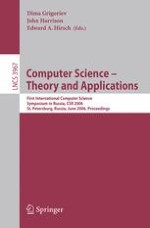2006 | Book
Computer Science – Theory and Applications
First International Computer Science Symposium in Russia, CSR 2006, St. Petersburg, Russia, June 8-12. 2006. Proceedings
Editors: Dima Grigoriev, John Harrison, Edward A. Hirsch
Publisher: Springer Berlin Heidelberg
Book Series : Lecture Notes in Computer Science
